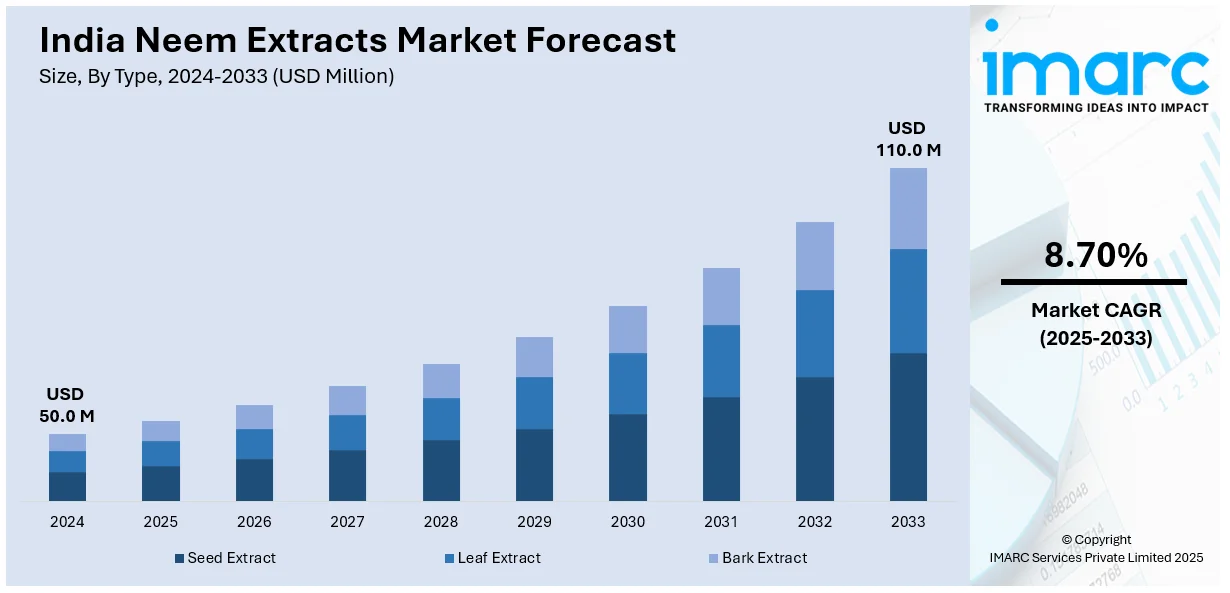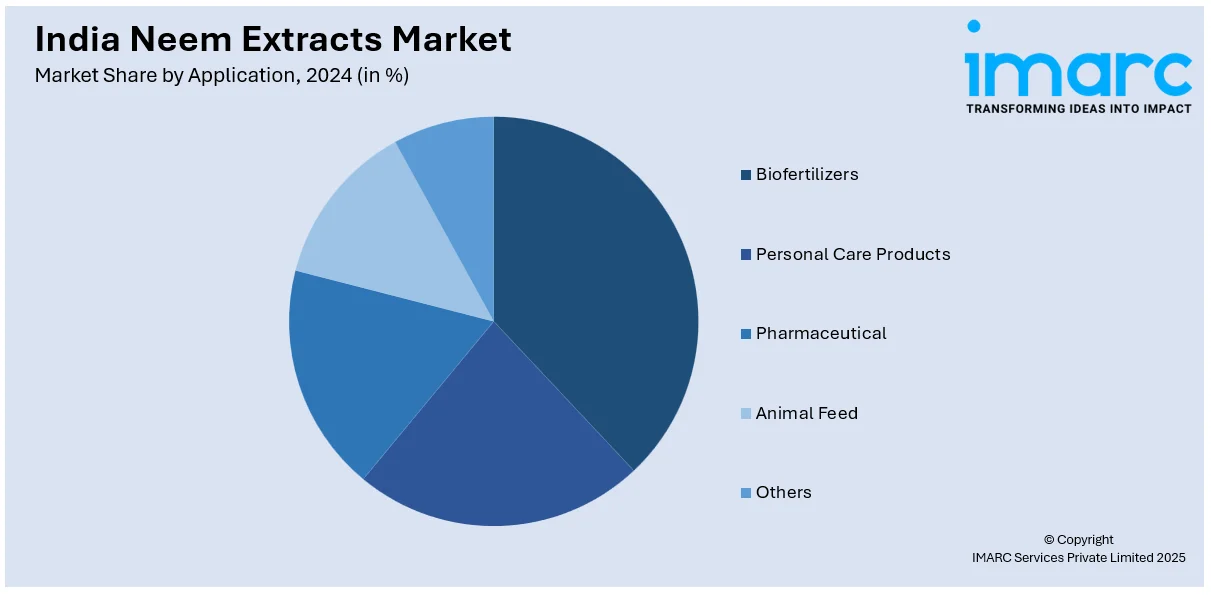
India Neem Extracts Market Size, Share, Trends and Forecast by Type, Application, and Region, 2025-2033
India Neem Extracts Market Overview:
The India neem extracts market size reached USD 50.0 Million in 2024. Looking forward, IMARC Group expects the market to reach USD 110.0 Million by 2033, exhibiting a growth rate (CAGR) of 8.70% during 2025-2033. The market is driven by increasing demand for organic and natural products in agriculture, personal care, and pharmaceuticals. Growing health consciousness, government support for sustainable practices, and the expansion of neem-based pharmaceutical applications, including immunity-enhancing and therapeutic products, are key factors fueling the India neem extracts market share.
|
Report Attribute
|
Key Statistics
|
|---|---|
|
Base Year
|
2024 |
|
Forecast Years
|
2025-2033
|
|
Historical Years
|
2019-2024
|
| Market Size in 2024 | USD 50.0 Million |
| Market Forecast in 2033 | USD 110.0 Million |
| Market Growth Rate 2025-2033 | 8.70% |
India Neem Extracts Market Trends:
Increasing Demand for Organic and Natural Products
The rising demand for organic and natural products across various industries is significantly supporting the India neem extracts market growth. Organic exports from India are expected to reach INR 20,000 crore (approximately USD 2,500 Million) by 2028 as against the current levels of INR 5,000-6,000 crore (approximately USD 625 Million-USD 750 Million), a 3 to 3.5 fold jump. The country is a global leader in organic farming, with over 1.7 million hectares of organic-certified land and 1.4 million organic farmers. Among the major export items are organic cereals, pulses, oilseed, spices, tree species, tea, and coffee, and they are in demand in these markets, including the USA, EU, and Japan. With a growing focus on health and the environment, phenol-free and chemical-free products are gaining popularity among consumers. Neem, known for its antifungal and antibacterial properties, neem is used in agriculture, personal care, and showcasing. Neem-derived biopesticides are widely used in agriculture as eco-friendly substitutes for synthetic pesticides. Additionally, neem extracts are being incorporated into personal care products including skin and hair care, and hygiene products due to their antibacterial and anti-inflammatory properties. Moreover, this is further strengthened through government efforts promoting organic farming and sustainable practices. As a result, manufacturers are investing in research and development to develop new neem-based products, stimulating market growth. This positive trend is expected to continue, driven by the growing demand for natural ingredients.

To get more information on this market, Request Sample
Expansion of Neem-Based Pharmaceutical Applications
The pharmaceutical sector is emerging as a key driver of growth in the market. A research report released by IMARC Group indicates that the pharmaceutical market in India was valued at USD 61.36 Billion in 2024. It is projected to grow to USD 174.31 Billion by 2033, reflecting a compound annual growth rate (CAGR) of 11.32% from 2025 to 2033. Neem has been recognized for its healing properties, antifungal, antiviral, and immune-enhancing properties as per the principles of Ayurvedic medicine. Recent studies conducted scientifically prove these benefits leading to more use of neem extracts in the formulation of medicines and dietary supplements. This trend has been accelerated due to the COVID-19 pandemic, with consumers gravitating towards products that support immunity and well-being. As a result, pharmaceutical manufacturers are incorporating neem extracts in formulations targeting skin diseases, diabetes, and oral health. Additionally, the rising prevalence of chronic diseases and the growing acceptance of herbal remedies are creating a positive India neem extracts market outlook. With India being a global hub for Ayurveda and natural medicine, the neem extracts market is poised for robust growth as pharmaceutical applications continue to expand, both domestically and internationally.
India Neem Extracts Market Segmentation:
IMARC Group provides an analysis of the key trends in each segment of the market, along with forecasts at the country level for 2025-2033. Our report has categorized the market based on type and application.
Type Insights:
- Seed Extract
- Leaf Extract
- Bark Extract
The report has provided a detailed breakup and analysis of the market based on the type. This includes seed extract, leaf extract, and bark extract.
Application Insights:

- Biofertilizers
- Personal Care Products
- Pharmaceutical
- Animal Feed
- Others
A detailed breakup and analysis of the market based on the application have also been provided in the report. This includes biofertilizers, personal care products, pharmaceutical, animal feed, and others.
Regional Insights:
- North India
- South India
- East India
- West India
The report has also provided a comprehensive analysis of all the major regional markets, which include North India, South India, East India, and West India.
Competitive Landscape:
The market research report has also provided a comprehensive analysis of the competitive landscape. Competitive analysis such as market structure, key player positioning, top winning strategies, competitive dashboard, and company evaluation quadrant has been covered in the report. Also, detailed profiles of all major companies have been provided.
India Neem Extracts Market News:
- July 06, 2024: ITC Nimyle launched the "Shuddh Shuruat" initiative on the occasion of Rath Yatra, to reinforce in the consumer's mind the values of purification and tradition by cleaning the Rath Yatra procession path with its neem-based floor cleaner. With the natural properties of neem extracts, Nimyle is certified by Greenpro and is supported by the World Neem Organization, which echoes India’s dedication to green cleaning. This campaign highlights the growing necessity for neem extracts in India, blending cultural reverence with responsible hygiene practices.
India Neem Extracts Market Report Coverage:
| Report Features | Details |
|---|---|
| Base Year of the Analysis | 2024 |
| Historical Period | 2019-2024 |
| Forecast Period | 2025-2033 |
| Units | Million USD |
| Scope of the Report | Exploration of Historical Trends and Market Outlook, Industry Catalysts and Challenges, Segment-Wise Historical and Future Market Assessment:
|
| Types Covered | Seed Extract, Leaf Extract, Bark Extract |
| Applications Covered | Biofertilizers, Personal Care Products, Pharmaceutical, Animal Feed, Others |
| Regions Covered | North India, South India, East India, West India |
| Customization Scope | 10% Free Customization |
| Post-Sale Analyst Support | 10-12 Weeks |
| Delivery Format | PDF and Excel through Email (We can also provide the editable version of the report in PPT/Word format on special request) |
Key Benefits for Stakeholders:
- IMARC’s industry report offers a comprehensive quantitative analysis of various market segments, historical and current market trends, market forecasts, and dynamics of the India neem extracts market from 2019-2033.
- The research report provides the latest information on the market drivers, challenges, and opportunities in the India neem extracts market.
- Porter's five forces analysis assist stakeholders in assessing the impact of new entrants, competitive rivalry, supplier power, buyer power, and the threat of substitution. It helps stakeholders to analyze the level of competition within the India neem extracts industry and its attractiveness.
- Competitive landscape allows stakeholders to understand their competitive environment and provides an insight into the current positions of key players in the market.
Key Questions Answered in This Report
The neem extracts market in India was valued at USD 50.0 Million in 2024.
The India neem extracts market is projected to exhibit a CAGR of 8.70% during 2025-2033, reaching a value of USD 110.0 Million by 2033.
The key factors driving the India neem extracts market include heightened need for organic and natural products, increasing adoption of eco-friendly agricultural inputs, expanding applications in pharmaceuticals and personal care, heightened health consciousness, and supportive government initiatives promoting sustainable farming and organic product development.
Need more help?
- Speak to our experienced analysts for insights on the current market scenarios.
- Include additional segments and countries to customize the report as per your requirement.
- Gain an unparalleled competitive advantage in your domain by understanding how to utilize the report and positively impacting your operations and revenue.
- For further assistance, please connect with our analysts.
 Request Customization
Request Customization
 Speak to an Analyst
Speak to an Analyst
 Request Brochure
Request Brochure
 Inquire Before Buying
Inquire Before Buying




.webp)




.webp)












